Project Management Report: Analyzing the Boeing 787 Dreamliner Project
VerifiedAdded on 2020/03/04
|8
|1463
|266
Report
AI Summary
This report provides a detailed analysis of the Boeing 787 Dreamliner project, focusing on the project management failures that led to significant delays and financial losses. The report examines key issues such as improper outsourcing strategies, including the neglect of in-house expertise and the adoption of new, untested outsourcing techniques. It also explores problems in communication procedures and inadequate risk management systems. The analysis delves into how these factors contributed to the project's setbacks, including supply chain management issues and the improper selection of systems. The report concludes with a critical evaluation of these issues, highlighting the lessons learned and suggesting improvements in project management practices. It emphasizes the importance of maintaining control over the design and manufacturing processes, valuing in-house expertise, and implementing robust risk management strategies to prevent similar failures in future projects.
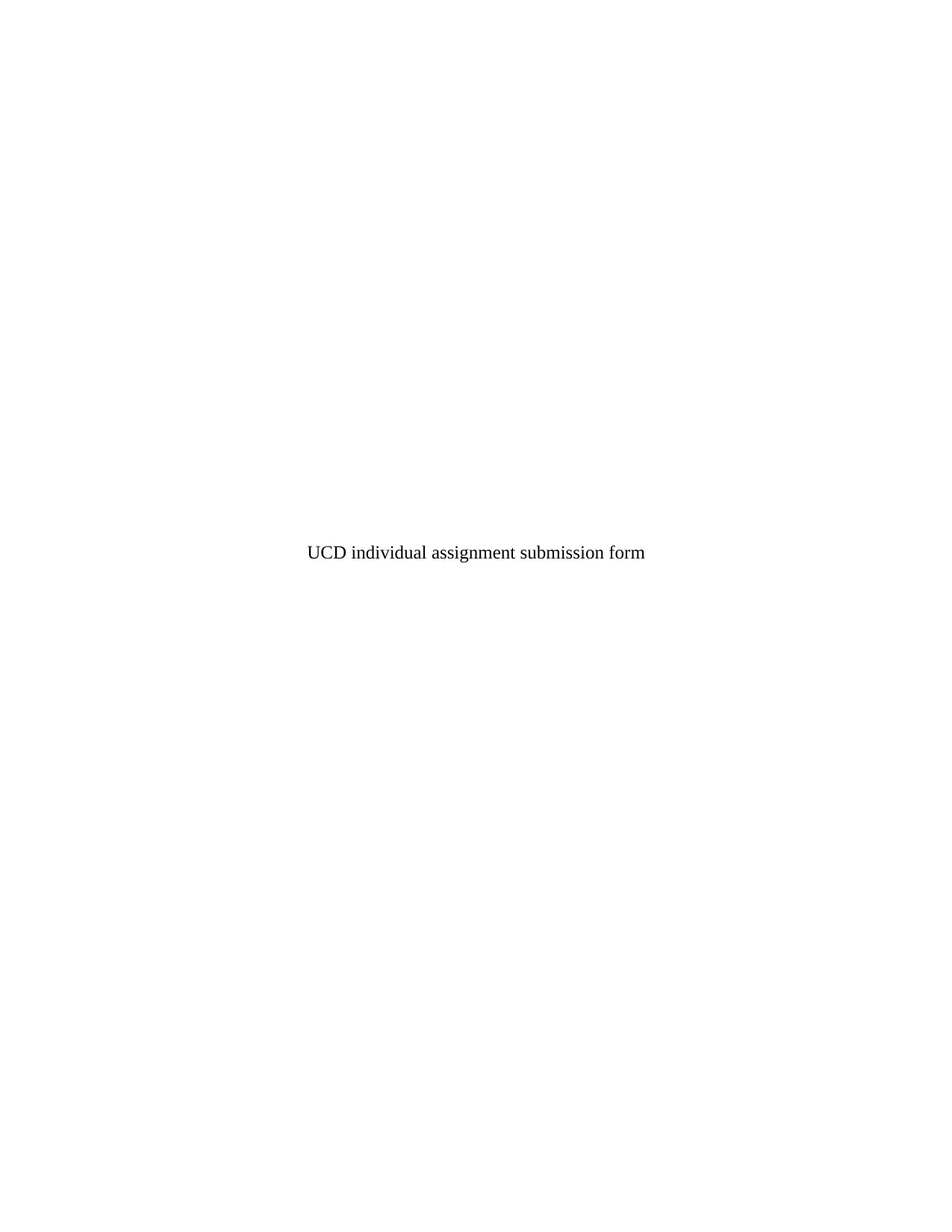
UCD individual assignment submission form
Paraphrase This Document
Need a fresh take? Get an instant paraphrase of this document with our AI Paraphraser
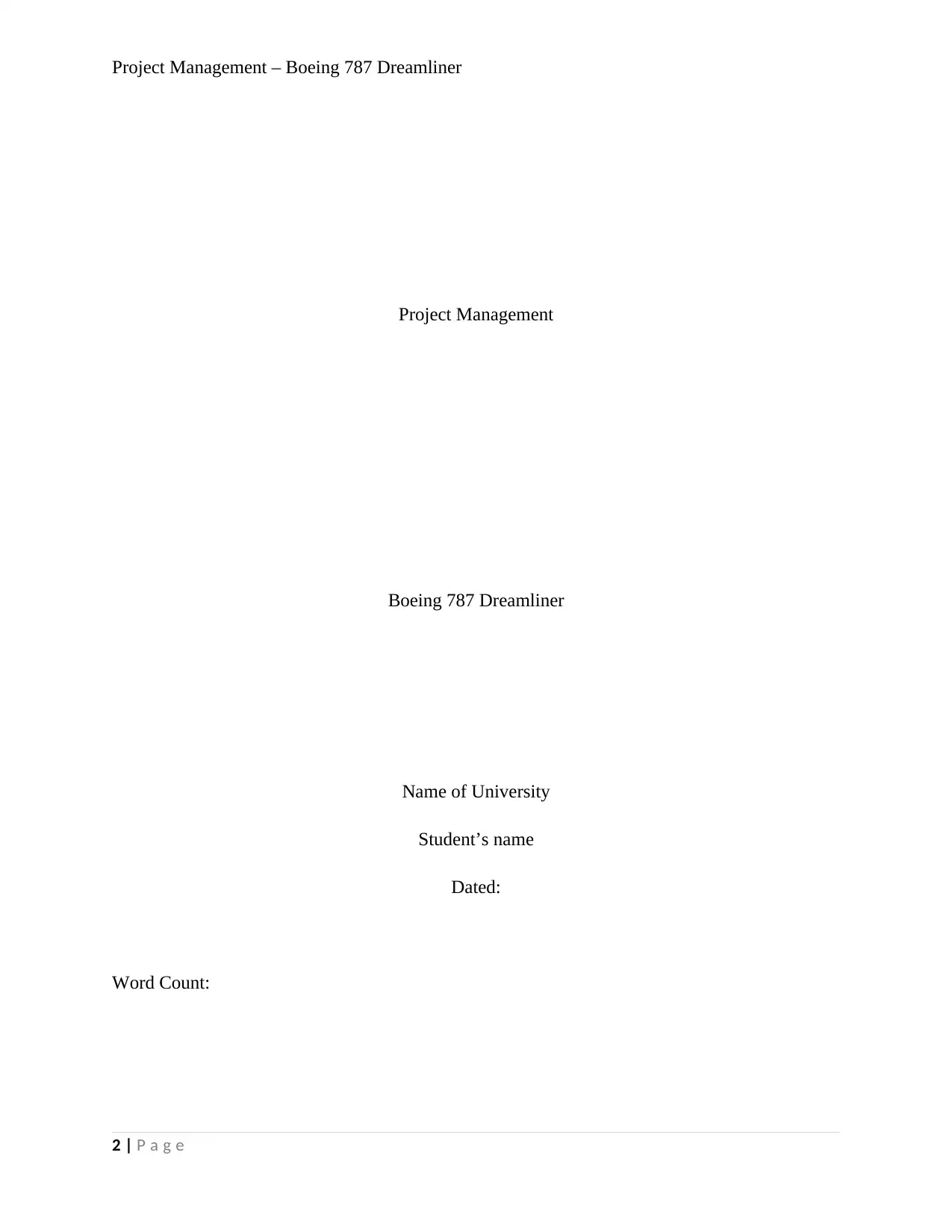
Project Management – Boeing 787 Dreamliner
Project Management
Boeing 787 Dreamliner
Name of University
Student’s name
Dated:
Word Count:
2 | P a g e
Project Management
Boeing 787 Dreamliner
Name of University
Student’s name
Dated:
Word Count:
2 | P a g e
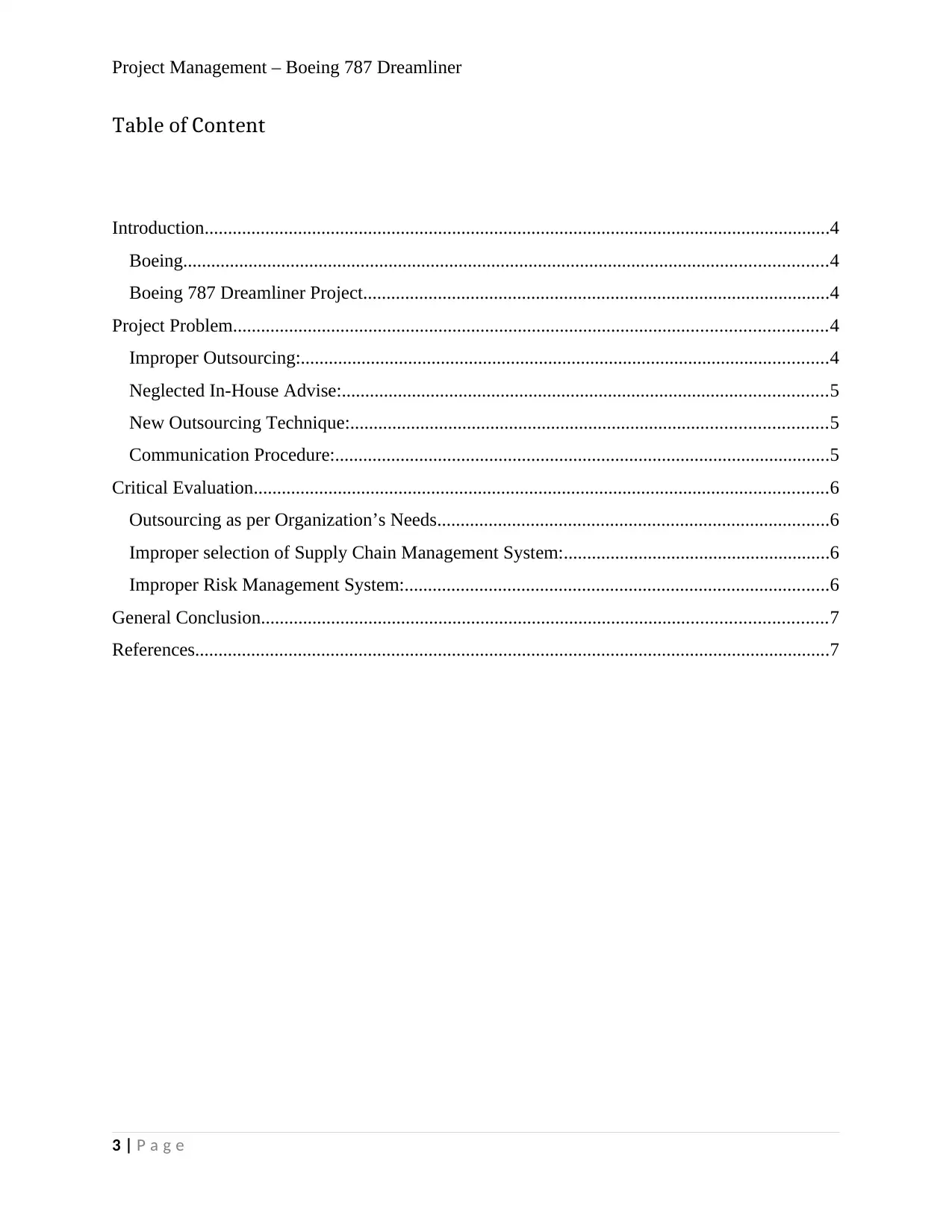
Project Management – Boeing 787 Dreamliner
Table of Content
Introduction......................................................................................................................................4
Boeing..........................................................................................................................................4
Boeing 787 Dreamliner Project....................................................................................................4
Project Problem...............................................................................................................................4
Improper Outsourcing:.................................................................................................................4
Neglected In-House Advise:........................................................................................................5
New Outsourcing Technique:......................................................................................................5
Communication Procedure:..........................................................................................................5
Critical Evaluation...........................................................................................................................6
Outsourcing as per Organization’s Needs....................................................................................6
Improper selection of Supply Chain Management System:.........................................................6
Improper Risk Management System:...........................................................................................6
General Conclusion.........................................................................................................................7
References........................................................................................................................................7
3 | P a g e
Table of Content
Introduction......................................................................................................................................4
Boeing..........................................................................................................................................4
Boeing 787 Dreamliner Project....................................................................................................4
Project Problem...............................................................................................................................4
Improper Outsourcing:.................................................................................................................4
Neglected In-House Advise:........................................................................................................5
New Outsourcing Technique:......................................................................................................5
Communication Procedure:..........................................................................................................5
Critical Evaluation...........................................................................................................................6
Outsourcing as per Organization’s Needs....................................................................................6
Improper selection of Supply Chain Management System:.........................................................6
Improper Risk Management System:...........................................................................................6
General Conclusion.........................................................................................................................7
References........................................................................................................................................7
3 | P a g e
⊘ This is a preview!⊘
Do you want full access?
Subscribe today to unlock all pages.

Trusted by 1+ million students worldwide
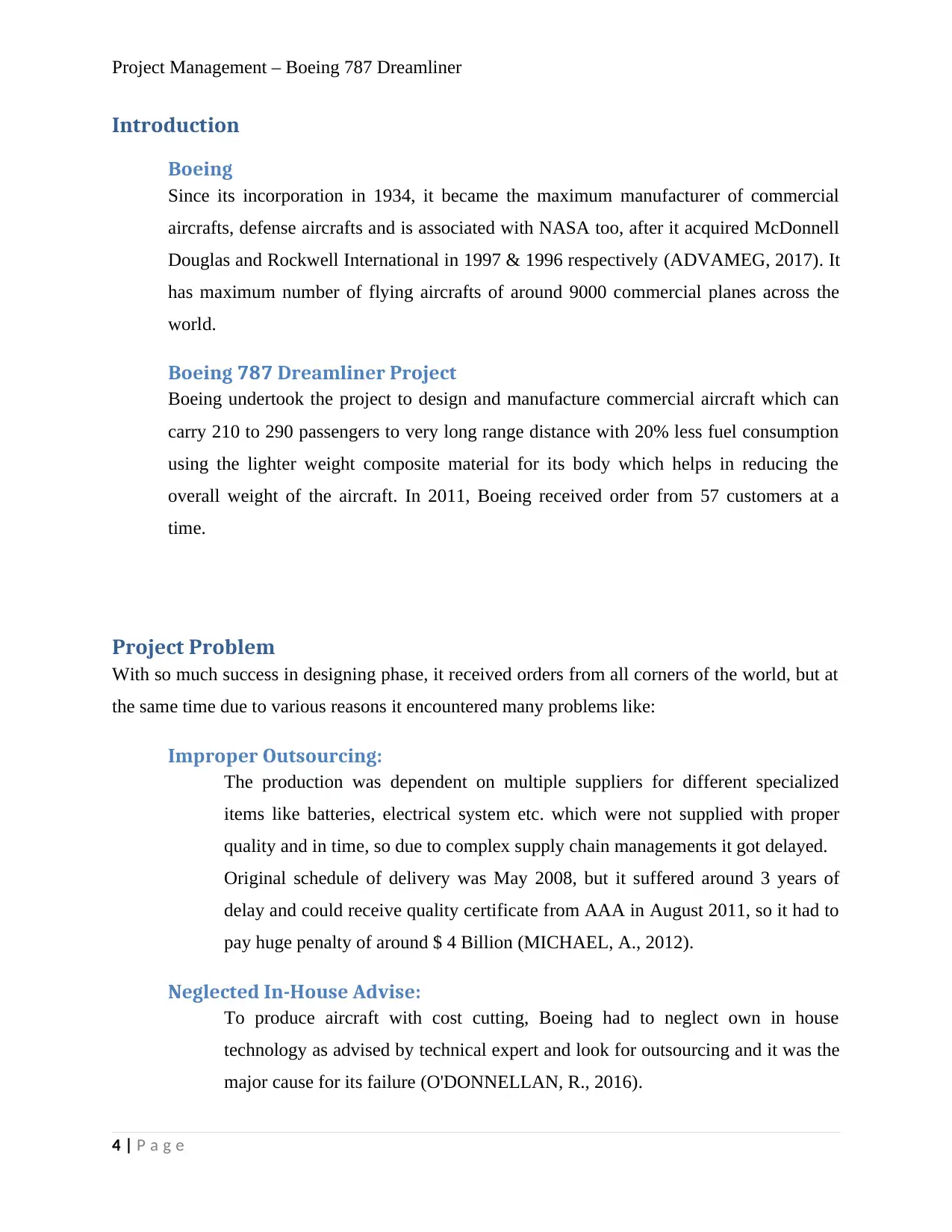
Project Management – Boeing 787 Dreamliner
Introduction
Boeing
Since its incorporation in 1934, it became the maximum manufacturer of commercial
aircrafts, defense aircrafts and is associated with NASA too, after it acquired McDonnell
Douglas and Rockwell International in 1997 & 1996 respectively (ADVAMEG, 2017). It
has maximum number of flying aircrafts of around 9000 commercial planes across the
world.
Boeing 787 Dreamliner Project
Boeing undertook the project to design and manufacture commercial aircraft which can
carry 210 to 290 passengers to very long range distance with 20% less fuel consumption
using the lighter weight composite material for its body which helps in reducing the
overall weight of the aircraft. In 2011, Boeing received order from 57 customers at a
time.
Project Problem
With so much success in designing phase, it received orders from all corners of the world, but at
the same time due to various reasons it encountered many problems like:
Improper Outsourcing:
The production was dependent on multiple suppliers for different specialized
items like batteries, electrical system etc. which were not supplied with proper
quality and in time, so due to complex supply chain managements it got delayed.
Original schedule of delivery was May 2008, but it suffered around 3 years of
delay and could receive quality certificate from AAA in August 2011, so it had to
pay huge penalty of around $ 4 Billion (MICHAEL, A., 2012).
Neglected In-House Advise:
To produce aircraft with cost cutting, Boeing had to neglect own in house
technology as advised by technical expert and look for outsourcing and it was the
major cause for its failure (O'DONNELLAN, R., 2016).
4 | P a g e
Introduction
Boeing
Since its incorporation in 1934, it became the maximum manufacturer of commercial
aircrafts, defense aircrafts and is associated with NASA too, after it acquired McDonnell
Douglas and Rockwell International in 1997 & 1996 respectively (ADVAMEG, 2017). It
has maximum number of flying aircrafts of around 9000 commercial planes across the
world.
Boeing 787 Dreamliner Project
Boeing undertook the project to design and manufacture commercial aircraft which can
carry 210 to 290 passengers to very long range distance with 20% less fuel consumption
using the lighter weight composite material for its body which helps in reducing the
overall weight of the aircraft. In 2011, Boeing received order from 57 customers at a
time.
Project Problem
With so much success in designing phase, it received orders from all corners of the world, but at
the same time due to various reasons it encountered many problems like:
Improper Outsourcing:
The production was dependent on multiple suppliers for different specialized
items like batteries, electrical system etc. which were not supplied with proper
quality and in time, so due to complex supply chain managements it got delayed.
Original schedule of delivery was May 2008, but it suffered around 3 years of
delay and could receive quality certificate from AAA in August 2011, so it had to
pay huge penalty of around $ 4 Billion (MICHAEL, A., 2012).
Neglected In-House Advise:
To produce aircraft with cost cutting, Boeing had to neglect own in house
technology as advised by technical expert and look for outsourcing and it was the
major cause for its failure (O'DONNELLAN, R., 2016).
4 | P a g e
Paraphrase This Document
Need a fresh take? Get an instant paraphrase of this document with our AI Paraphraser
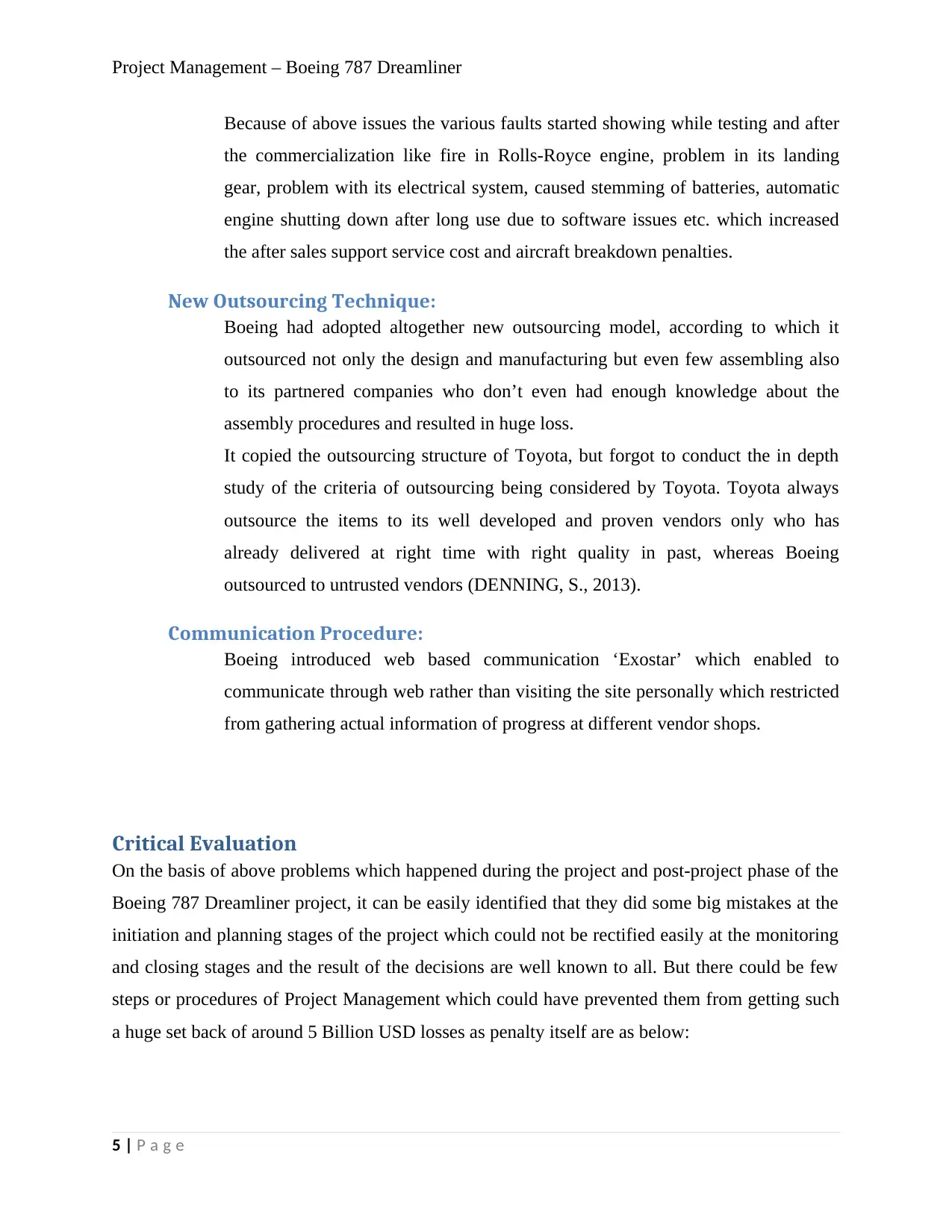
Project Management – Boeing 787 Dreamliner
Because of above issues the various faults started showing while testing and after
the commercialization like fire in Rolls-Royce engine, problem in its landing
gear, problem with its electrical system, caused stemming of batteries, automatic
engine shutting down after long use due to software issues etc. which increased
the after sales support service cost and aircraft breakdown penalties.
New Outsourcing Technique:
Boeing had adopted altogether new outsourcing model, according to which it
outsourced not only the design and manufacturing but even few assembling also
to its partnered companies who don’t even had enough knowledge about the
assembly procedures and resulted in huge loss.
It copied the outsourcing structure of Toyota, but forgot to conduct the in depth
study of the criteria of outsourcing being considered by Toyota. Toyota always
outsource the items to its well developed and proven vendors only who has
already delivered at right time with right quality in past, whereas Boeing
outsourced to untrusted vendors (DENNING, S., 2013).
Communication Procedure:
Boeing introduced web based communication ‘Exostar’ which enabled to
communicate through web rather than visiting the site personally which restricted
from gathering actual information of progress at different vendor shops.
Critical Evaluation
On the basis of above problems which happened during the project and post-project phase of the
Boeing 787 Dreamliner project, it can be easily identified that they did some big mistakes at the
initiation and planning stages of the project which could not be rectified easily at the monitoring
and closing stages and the result of the decisions are well known to all. But there could be few
steps or procedures of Project Management which could have prevented them from getting such
a huge set back of around 5 Billion USD losses as penalty itself are as below:
5 | P a g e
Because of above issues the various faults started showing while testing and after
the commercialization like fire in Rolls-Royce engine, problem in its landing
gear, problem with its electrical system, caused stemming of batteries, automatic
engine shutting down after long use due to software issues etc. which increased
the after sales support service cost and aircraft breakdown penalties.
New Outsourcing Technique:
Boeing had adopted altogether new outsourcing model, according to which it
outsourced not only the design and manufacturing but even few assembling also
to its partnered companies who don’t even had enough knowledge about the
assembly procedures and resulted in huge loss.
It copied the outsourcing structure of Toyota, but forgot to conduct the in depth
study of the criteria of outsourcing being considered by Toyota. Toyota always
outsource the items to its well developed and proven vendors only who has
already delivered at right time with right quality in past, whereas Boeing
outsourced to untrusted vendors (DENNING, S., 2013).
Communication Procedure:
Boeing introduced web based communication ‘Exostar’ which enabled to
communicate through web rather than visiting the site personally which restricted
from gathering actual information of progress at different vendor shops.
Critical Evaluation
On the basis of above problems which happened during the project and post-project phase of the
Boeing 787 Dreamliner project, it can be easily identified that they did some big mistakes at the
initiation and planning stages of the project which could not be rectified easily at the monitoring
and closing stages and the result of the decisions are well known to all. But there could be few
steps or procedures of Project Management which could have prevented them from getting such
a huge set back of around 5 Billion USD losses as penalty itself are as below:
5 | P a g e
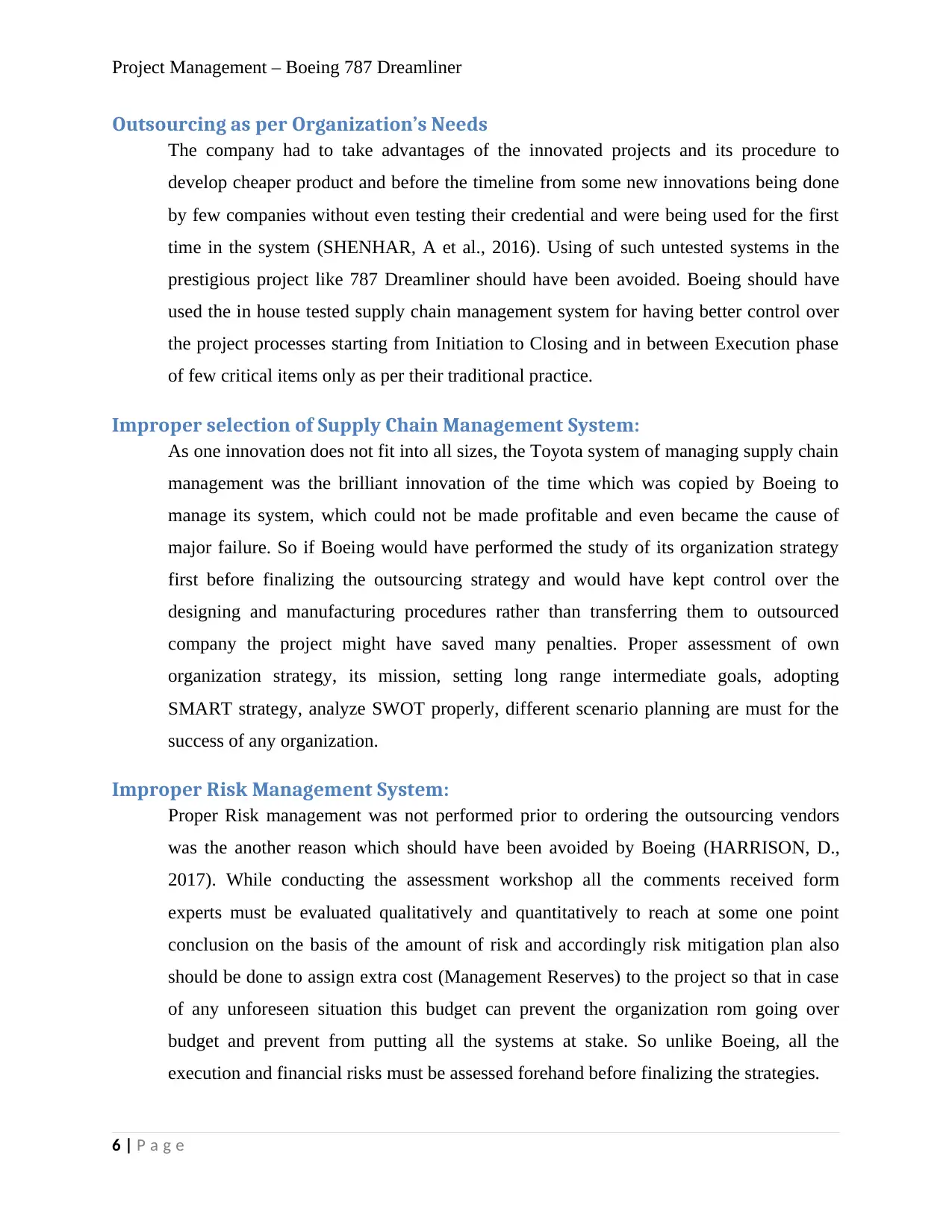
Project Management – Boeing 787 Dreamliner
Outsourcing as per Organization’s Needs
The company had to take advantages of the innovated projects and its procedure to
develop cheaper product and before the timeline from some new innovations being done
by few companies without even testing their credential and were being used for the first
time in the system (SHENHAR, A et al., 2016). Using of such untested systems in the
prestigious project like 787 Dreamliner should have been avoided. Boeing should have
used the in house tested supply chain management system for having better control over
the project processes starting from Initiation to Closing and in between Execution phase
of few critical items only as per their traditional practice.
Improper selection of Supply Chain Management System:
As one innovation does not fit into all sizes, the Toyota system of managing supply chain
management was the brilliant innovation of the time which was copied by Boeing to
manage its system, which could not be made profitable and even became the cause of
major failure. So if Boeing would have performed the study of its organization strategy
first before finalizing the outsourcing strategy and would have kept control over the
designing and manufacturing procedures rather than transferring them to outsourced
company the project might have saved many penalties. Proper assessment of own
organization strategy, its mission, setting long range intermediate goals, adopting
SMART strategy, analyze SWOT properly, different scenario planning are must for the
success of any organization.
Improper Risk Management System:
Proper Risk management was not performed prior to ordering the outsourcing vendors
was the another reason which should have been avoided by Boeing (HARRISON, D.,
2017). While conducting the assessment workshop all the comments received form
experts must be evaluated qualitatively and quantitatively to reach at some one point
conclusion on the basis of the amount of risk and accordingly risk mitigation plan also
should be done to assign extra cost (Management Reserves) to the project so that in case
of any unforeseen situation this budget can prevent the organization rom going over
budget and prevent from putting all the systems at stake. So unlike Boeing, all the
execution and financial risks must be assessed forehand before finalizing the strategies.
6 | P a g e
Outsourcing as per Organization’s Needs
The company had to take advantages of the innovated projects and its procedure to
develop cheaper product and before the timeline from some new innovations being done
by few companies without even testing their credential and were being used for the first
time in the system (SHENHAR, A et al., 2016). Using of such untested systems in the
prestigious project like 787 Dreamliner should have been avoided. Boeing should have
used the in house tested supply chain management system for having better control over
the project processes starting from Initiation to Closing and in between Execution phase
of few critical items only as per their traditional practice.
Improper selection of Supply Chain Management System:
As one innovation does not fit into all sizes, the Toyota system of managing supply chain
management was the brilliant innovation of the time which was copied by Boeing to
manage its system, which could not be made profitable and even became the cause of
major failure. So if Boeing would have performed the study of its organization strategy
first before finalizing the outsourcing strategy and would have kept control over the
designing and manufacturing procedures rather than transferring them to outsourced
company the project might have saved many penalties. Proper assessment of own
organization strategy, its mission, setting long range intermediate goals, adopting
SMART strategy, analyze SWOT properly, different scenario planning are must for the
success of any organization.
Improper Risk Management System:
Proper Risk management was not performed prior to ordering the outsourcing vendors
was the another reason which should have been avoided by Boeing (HARRISON, D.,
2017). While conducting the assessment workshop all the comments received form
experts must be evaluated qualitatively and quantitatively to reach at some one point
conclusion on the basis of the amount of risk and accordingly risk mitigation plan also
should be done to assign extra cost (Management Reserves) to the project so that in case
of any unforeseen situation this budget can prevent the organization rom going over
budget and prevent from putting all the systems at stake. So unlike Boeing, all the
execution and financial risks must be assessed forehand before finalizing the strategies.
6 | P a g e
⊘ This is a preview!⊘
Do you want full access?
Subscribe today to unlock all pages.

Trusted by 1+ million students worldwide
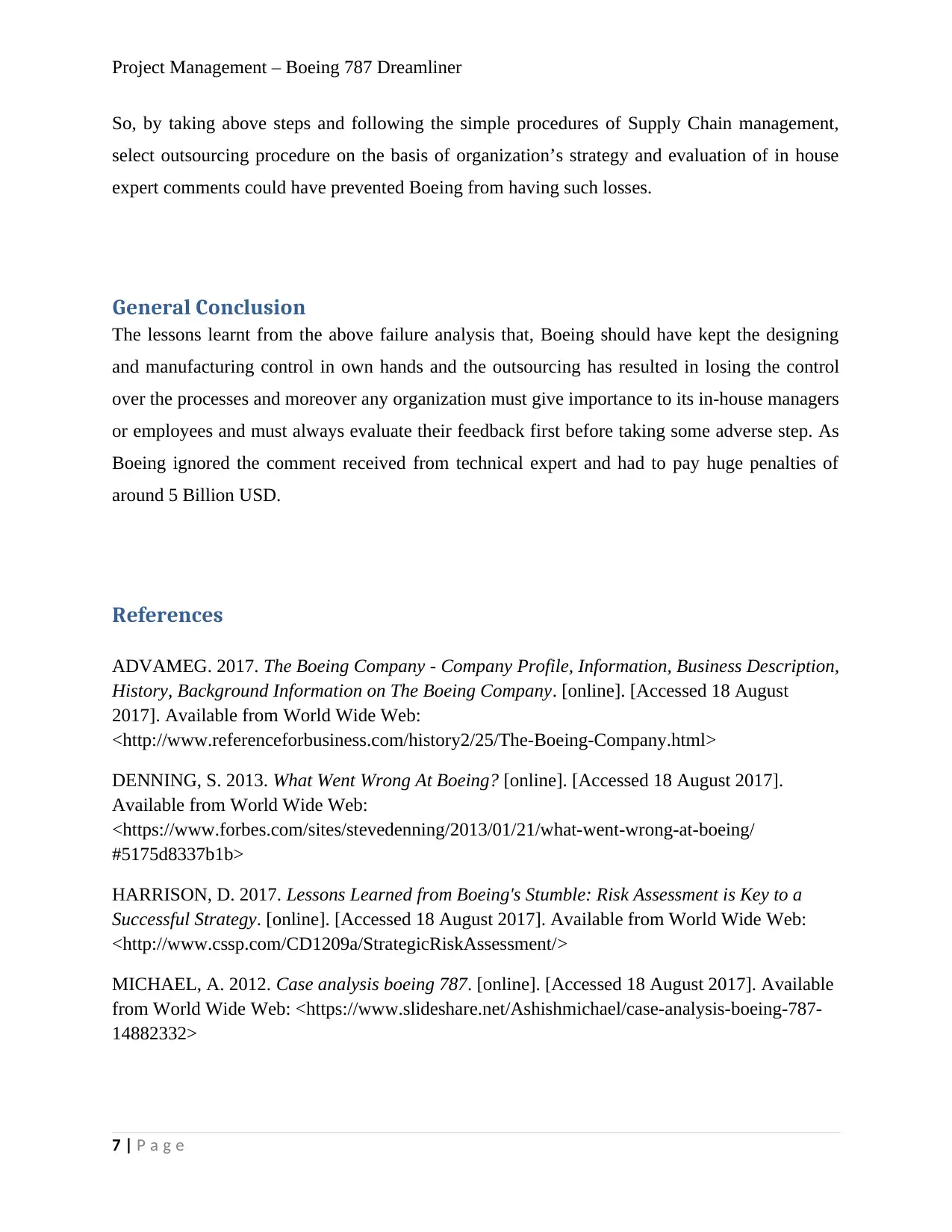
Project Management – Boeing 787 Dreamliner
So, by taking above steps and following the simple procedures of Supply Chain management,
select outsourcing procedure on the basis of organization’s strategy and evaluation of in house
expert comments could have prevented Boeing from having such losses.
General Conclusion
The lessons learnt from the above failure analysis that, Boeing should have kept the designing
and manufacturing control in own hands and the outsourcing has resulted in losing the control
over the processes and moreover any organization must give importance to its in-house managers
or employees and must always evaluate their feedback first before taking some adverse step. As
Boeing ignored the comment received from technical expert and had to pay huge penalties of
around 5 Billion USD.
References
ADVAMEG. 2017. The Boeing Company - Company Profile, Information, Business Description,
History, Background Information on The Boeing Company. [online]. [Accessed 18 August
2017]. Available from World Wide Web:
<http://www.referenceforbusiness.com/history2/25/The-Boeing-Company.html>
DENNING, S. 2013. What Went Wrong At Boeing? [online]. [Accessed 18 August 2017].
Available from World Wide Web:
<https://www.forbes.com/sites/stevedenning/2013/01/21/what-went-wrong-at-boeing/
#5175d8337b1b>
HARRISON, D. 2017. Lessons Learned from Boeing's Stumble: Risk Assessment is Key to a
Successful Strategy. [online]. [Accessed 18 August 2017]. Available from World Wide Web:
<http://www.cssp.com/CD1209a/StrategicRiskAssessment/>
MICHAEL, A. 2012. Case analysis boeing 787. [online]. [Accessed 18 August 2017]. Available
from World Wide Web: <https://www.slideshare.net/Ashishmichael/case-analysis-boeing-787-
14882332>
7 | P a g e
So, by taking above steps and following the simple procedures of Supply Chain management,
select outsourcing procedure on the basis of organization’s strategy and evaluation of in house
expert comments could have prevented Boeing from having such losses.
General Conclusion
The lessons learnt from the above failure analysis that, Boeing should have kept the designing
and manufacturing control in own hands and the outsourcing has resulted in losing the control
over the processes and moreover any organization must give importance to its in-house managers
or employees and must always evaluate their feedback first before taking some adverse step. As
Boeing ignored the comment received from technical expert and had to pay huge penalties of
around 5 Billion USD.
References
ADVAMEG. 2017. The Boeing Company - Company Profile, Information, Business Description,
History, Background Information on The Boeing Company. [online]. [Accessed 18 August
2017]. Available from World Wide Web:
<http://www.referenceforbusiness.com/history2/25/The-Boeing-Company.html>
DENNING, S. 2013. What Went Wrong At Boeing? [online]. [Accessed 18 August 2017].
Available from World Wide Web:
<https://www.forbes.com/sites/stevedenning/2013/01/21/what-went-wrong-at-boeing/
#5175d8337b1b>
HARRISON, D. 2017. Lessons Learned from Boeing's Stumble: Risk Assessment is Key to a
Successful Strategy. [online]. [Accessed 18 August 2017]. Available from World Wide Web:
<http://www.cssp.com/CD1209a/StrategicRiskAssessment/>
MICHAEL, A. 2012. Case analysis boeing 787. [online]. [Accessed 18 August 2017]. Available
from World Wide Web: <https://www.slideshare.net/Ashishmichael/case-analysis-boeing-787-
14882332>
7 | P a g e
Paraphrase This Document
Need a fresh take? Get an instant paraphrase of this document with our AI Paraphraser
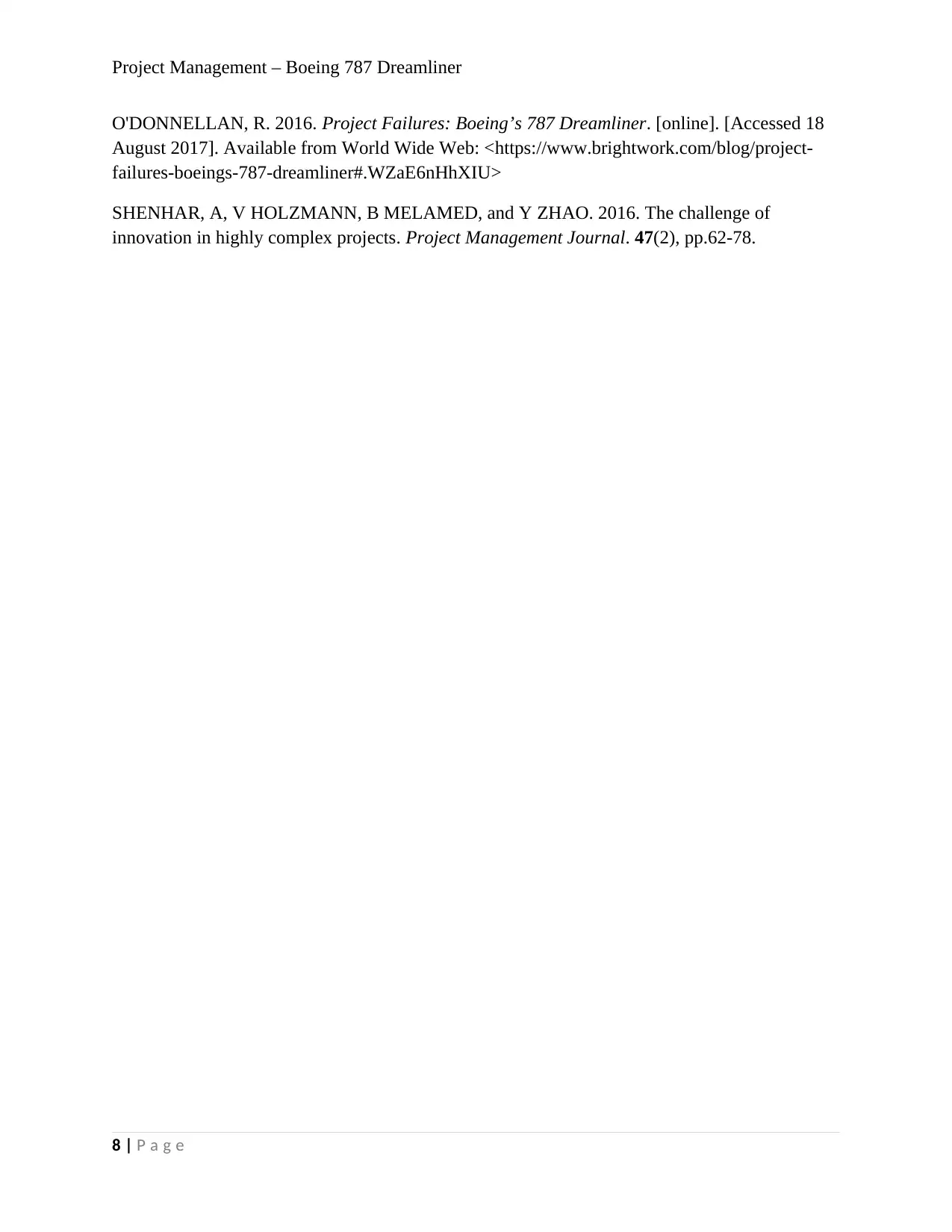
Project Management – Boeing 787 Dreamliner
O'DONNELLAN, R. 2016. Project Failures: Boeing’s 787 Dreamliner. [online]. [Accessed 18
August 2017]. Available from World Wide Web: <https://www.brightwork.com/blog/project-
failures-boeings-787-dreamliner#.WZaE6nHhXIU>
SHENHAR, A, V HOLZMANN, B MELAMED, and Y ZHAO. 2016. The challenge of
innovation in highly complex projects. Project Management Journal. 47(2), pp.62-78.
8 | P a g e
O'DONNELLAN, R. 2016. Project Failures: Boeing’s 787 Dreamliner. [online]. [Accessed 18
August 2017]. Available from World Wide Web: <https://www.brightwork.com/blog/project-
failures-boeings-787-dreamliner#.WZaE6nHhXIU>
SHENHAR, A, V HOLZMANN, B MELAMED, and Y ZHAO. 2016. The challenge of
innovation in highly complex projects. Project Management Journal. 47(2), pp.62-78.
8 | P a g e
1 out of 8
Related Documents
Your All-in-One AI-Powered Toolkit for Academic Success.
+13062052269
info@desklib.com
Available 24*7 on WhatsApp / Email
![[object Object]](/_next/static/media/star-bottom.7253800d.svg)
Unlock your academic potential
Copyright © 2020–2025 A2Z Services. All Rights Reserved. Developed and managed by ZUCOL.



